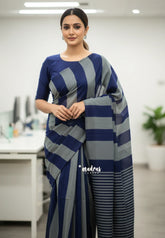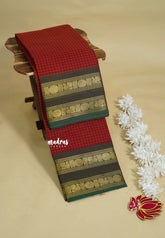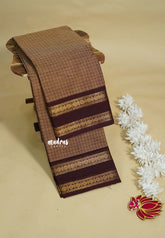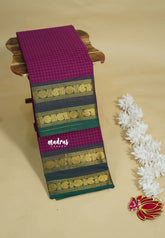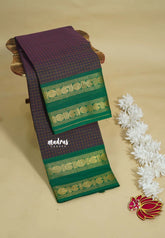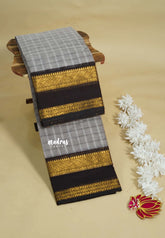Madras Sarees and Their South Indian Roots (Vintage Gadwal)

If you have ever worn or seen someone wearing a Gadwal saree, you will understand that there is something special about it. It is elegant, light, and deeply rooted in the South Indian culture.
Madras Sarees is a popular name in this industry, offering beautiful sarees that uphold the traditional artistry and heritage of Indian clothing for women.
In this article, we will talk about what Madras Sarees is doing to bring the aesthetic of Vintage Gadwal silk sarees to the current generation and how these sarees connect us to a deep weaving history of South India.
Where are Gadwal sarees made?
Gadwal sarees are made in Gadwal, a small township in the state of Telangana, South India. The weavers of Gadwal sarees have been crafting this piece for ages.
In fact, Gadwal sarees have now been labelled with a Geographical Indication (GI) tag as a traditional and authentic product from that part of the world.
If you’re wondering what is so special about a regular Gadwal saree, the answer is everything.
It has a cotton body which makes it very breathable and comfortable, silk borders which contribute to rich contrast, and a zari pallu, which is the decorative ending of a saree.
This combination of silk and cotton offers structure to your look while looking soft.
The Vintage Gadwal Collection at Madras Sarees
The foundation of Madras Sarees is to showcase the stunning traditional attire of South Indian women.
The brand utilises inspiration and materials from southern India as a whole. The Vintage Gadwal collection shows the beauty of Telangana ethnic attire.
The deep colours include maroon, royal blue, violet, green and others, combined with the vintage feel to connect the past with the present.
The Vintage Gadwal collection features the best sarees from South India: stunningly draped across the body with contrasting silk borders and a heavy, tasselled pallu.
The sarees are about 6.3 meters to allow for a full drape. The saree is both from soft cotton and has the sheen of silk, because of which you can use it suitably for daily use or formal occasions.
You can also adorn a vintage Gadwal saree can be worn to the temple, a family function, or a festive occasion.
Ready to wear a piece of South Indian heritage?
Discover the elegance of Vintage Gadwal sarees exclusively at Madras Sarees.
Shop Now & embrace tradition with every drape!
Difference between Gadwal and Kanchipuram sarees
Also, one of the questions many women ask is how Gadwal silk sarees compare to pure Kanchipuram sarees, which are also known as Kanjivaram pure silk sarees.
Both Gadwal sarees and Kanchipuram sarees are commonly worn sarees in South India, but there are a number of differences.
Originating primarily from Tamil Nadu, Kanchipuram sarees are known for their royalty, stunning texture, and polished silk.
Traditionally, pure Kanchipuram silk sarees are made of silk with broad and detailed zari borders and heavy pallus. Kanchipuram silks are primarily worn by brides on the day of their wedding and most other grand occasions.
On the other hand, Gadwal sarees provide a lighter option. Made of silk-cotton, they provide a breathable, manageable cloth that is flexible for day-to-day traditional wear.
Kanchipuram sarees are opulent and royal, whereas Gadwal sarees are nice and practical: this is the basic difference between Gadwal & Kanchipuram sarees.
Each one presents a different need and occasion value, and makes for an essential piece for every individual who is fond of South Indian silk sarees.
South Indian Sarees: Keeping up their heritage
A South Indian silk saree is more than just a piece of clothing. It is a representation of tradition, community, and pride.
Women in Tamil Nadu, Andhra Pradesh, Karnataka, and Telangana wear sarees as their everyday clothing and in special ceremonies.
Whether it is a pure Kanchipuram silk saree worn by a bride on her wedding day or a simple Gadwal to be worn for a pooja, each garment speaks to a regional specificity of culture and tradition.
For the ideal look, pair your Gadwal saree with antique or temple jewellery that matches the zari in the border and pallu.
Use a high-neck blouse, a traditional bun, and light makeup for a classy and understated look. For pastel shades like soft violet or pink, try pearls or kundan jewellery for a lighter, modern look.
Care & Maintenance Tips for Gadwal Sarees from Madras Sarees
Like all handwoven sarees, the Gadwal sarees require a little extra care to keep them pristine.
It is best to handwash the sarees with cold water, or on a delicate machine cycle at a moderate 30-degree water temperature, with a gentle detergent. Always air dry in the shade.
This will keep the silk from being damaged and losing its colour.
When storing, fold the sarees as neatly as possible in cotton or muslin cloth, and avoid plastic dry-cleaning covers that could encourage mildew or mould by keeping the fabric sealed away with no air.
By following these recommendations, these South Indian silk sarees can last for years to come, and often make good family heirlooms.
Final thoughts
The Vintage Gadwal sarees have a story to tell that is far deeper than fashion; they are about heritage, identity, and pride.
This saree is also a beautiful example of the traditional attire of South Indian women, with elements of both beauty and functionality.
Whether it’s a Kanjivaram silk saree for that wedding, or a Gadwal saree for that family get-together, they are both wonderful choices from the immense world of the best sarees from South India.
With Madras Sarees, these historic weaves are getting new life and being incorporated into modern wardrobes.
If you love to mix tradition with modernity, then here is your chance to experience the timelessness of a South Indian saree, beginning with Gadwal.
New stories, new styles! Our July blog is on its way so stay connected for more saree love.
Want to explore more about the beauty of South Indian sarees and how to style them?
Check out our latest blog on timeless saree fashion and traditional styling tips here:
FAQs

